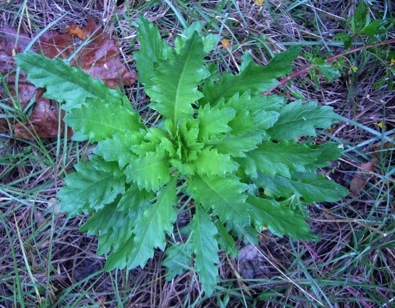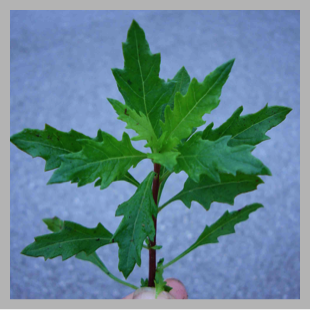Mexican Tea, Dewormer: Epazote
Here is my dedication to being comprehensive: I am going to write about a plant I do not like.
Why don’t I like Epazote? Because it smells intensely like varnish to me, and while I don’t mind varnish smelling like varnish, it is hard for me to get past that odor in food. Grubs I can eat but not Epazote. Yes, there are those who sing its praise such as New York City’s wild food teacher Steve Brill.
Chenopodium ambrosioides (ke-no-POE-dee-um am-bro-zhee-OY-deez) is the malodorous cousin of Chenopodium album (AL-bum) better known as Lamb’s Quarters. C. ambrosioides is as rank as C. album is mild. It’s hard to believe they are related plants, and perhaps why C. ambrosioideshas been renamed about a
dozen times. Chenopodium ambrosioides, by the way, means ‘resembles Ambrosia’ (ragweed.) That should give you some idea of what it smells like. Its second name, is Teloxys ambrosioides, (tel-OX-ees ) (Greek telos [τέλος] “end, purpose” and oxys [ὀξύς] “sharp, acidic, acute”) means…”sharp-ending leaf.” That name change would be a good one if it sticks. The C. album does have a leaf shaped like a goose foot. C. ambrosioides is not shaped like a goose foot but does have a leaf ending in sharply defined points. A third botanical name is Dysphania ambrosioides, Dysphania (dis-FAY-nee-ah) is Greek from dysphanis for “obscure,” referring to the inconspicuous flowers. Frankly, if the gods like this plant it is time to be an atheist. Oh, and they don’t make a tea out of it. In this case, the word “tea” is used to mean an infusion, not a pleasant drink. Up until about 1940 the oil of this plant was the main oil used to treat internal worms in man and beast, dogs in particular. It was sometimes called “Baltimore Oil” after a company in that city that processed much of it. I bet that was a pleasant place to work. Modern treatments replaced C. ambrosioides oil but it is still used in many places.
Purified oil made from C. ambrosioides is very toxic. Little is known, however, about the toxicity of fresh and dried plants or how toxic reactions occur. Signs of toxicity include salivation, increased heart rate and respiration, changes in blood chemistry, and convulsions. Oil of C. ambrosioides can cause skin reactions, and it is dangerous to inhale. The dose that gets rid of parasites is close to the toxic dose. I’m not sure I want that in my refried beans, even if it does reduce gas.
What is somewhat surprising is references to Epazote where it is native pull no punches. It is the called the stinking weed, smelly and all that. But, northern civilizations where it is not native call it lemon-ish or citronella-ish, refreshing et cetera. I think there is something drastically wrong there, but then again, my nose is Mediterranean not Scandinavian.
Unmistakably smelling of spar varnish, it is a common spice in Mexican cooking. Epazote (EP-ah-zoht) is from Nahuatl, the Aztec language, and means skunk sweat or skunk dirt. By now it should be rather clear that this plant has an odor issue. One does not need to cultivate Epazote in Florida, or buy it. Epazote grows quite happily nearly everywhere. I might have a different view of Epazote if I had tried it cooked sometime. But, I also don’t have internal worms and I really don’t want to find out if the line between Mexican spice and Mexican worm killer is thin. I will let a chef convince me in Some dish of his choosing.
Similar looking: The composite “fireweed” Erechtites hieracifolia when young can resemble the C.ambrosioides and while the fireweed is edible, it is not too palatable. But in its favor Fireweed does not smell of varnish but more like celery oil. Also if I remeber correctly Fireweed is a bit hairy and the goosefoot food of the gods is not.
All of that said, there is a new potential use for the smelly food of the gods. A study in August 2007 showed it is effective against the protozoa that cause Leishmaniasis, a fly-carried disease which effects 12 million people in 88 countries. This may lead to new drugs to treat the disease.
Green Deane’s “Itemized” Plant Profile
IDENTIFICATION: An herb to that grows to a height of 40 inches or so. The leaves are lance shaped and toothed, flowers are small and green, seeds very small and green when fresh and black when dry. The plant has an extremely strong odor that should remind you of cleaning paint brushes or perhaps citrus. Some people have an instant allergic reaction to the plant so approach cautiously.
TIME OF YEAR: In Florida, year round, grows tall and rank through the year.
ENVIRONMENT: Waste ground, dumps, fields, railroads, roadsides, trails, abandoned fields.
METHOD OF PREPARATION: Leaves, flowers and unripe fruits; the latter have the strongest flavor. Said to be best used when fresh but dried can be used as well. It is used fresh in soups, salads and meat dishes. The most common usage is, however, in bean dishes, where it’s strong anti-flatulent powers are praised. Young leaves are better than old leaves, and the seeds are edible, too.




take chenopodium benosioides before, and there’ll be no gas.
Fresh epazote leaves are actually delicious. They are used to flavor black beans. They are also used to flavor fish soup, and are very tasty in quezadillas made from Oaxacan, goat’s milk or farmer’s cheese in corn tortillas. They lose their pungent smell when cooked. Surprisingly, they taste good raw in the cheese and corn tortilla quezadillas! Epazote is awesome if you know how to use it!
Hi,
Can a couple of million Mexican be stupid enough to intoxicate themselves for the past 20 generations? May I suggest using epazote when cooking mexican food. It is a condiment with a special tang.
In matters of taste there is no argument. If you like it eat it. To me it smells and tastes like toilet cleaner. Given the case I thought me doing a video and article on a food I personally find offensive was darn good of me.
Your articles are so interesting,however your dry wit makes me laugh!Thank-you, we all need to laugh more in these times.
How far north does it grow?
I have friends who harvest it in New York.
It is nearly invasive … and grows just fine on the US/Canadian border….
Can this be propagated like other herbs?
Yes, easily.
my epasote plants smell like public toilets. I envy you smelling varnish there! I wish my plants were at least as fragrant!
Can one eat the flowers as well as the leaves?
By the way this is delicious in Mexican black beans! And helps reduce gas after eating them!
Nobody is going to boil up a mess of epazote greens for sure. However four sprigs of epazote in a pot of pinto beans with garlic cayenne some Mexican oregano and this is good eating. Your mouth will not say varnish or turpentine.
I enjoyed this article just for the humor.
On a more serious note, I wonder if the odor is related somehow to soil chemistry or climate, or what strain it is. If it isn’t that, maybe it’s a genetic difference among humans, like the difference between people who think cilantro is delicious, and those who know that it actually tastes like soap.
Just to show how different folks can be, I think this plant smells very pleasantly of resinous citrus. To each nose their own.
I found this foul smelling weed growing behind our house in WV. I had no idea what it was until my hub looked it up in his plant ID book. It stunk and it was ‘Mexican tea’. I can’t imagine who would want to drink it, to me the plant smelled like used motor oil. Sometimes the birds grace us with wonderful plants like magic lilies and perennial ‘morning glories’, other times they dump this stuff on us. Thanks for letting us know what that stinky weed is. I love Mexican food, but would do without that ‘spice’. 😛
Hello, my name is Gabriela I would know if you can help me out. I would know if you can send me some Epazote seeds? I would love to grow my own. they are so hard to come by in Oregon. So thank you so much.
Does it grow in or near central California? I think I came across this weed growing by the American River, but California is a long way away from Florida…just wanna make sure I have the correct plant.
It definitely grows all around the rivers here in cali! I found a bunch by the Yuba just yesterday!
In Panama (and I think Peru) they call it Paico. Drinking a tea, morning, on an empty stomach, for three days is a common treatment for parasites.
There is some Mexicans in our apartment complex directly below us that is cooking something very strong every night. I am thinking it’s a drug, but not 100% on it. It smells like paint among other things and our air detector shows this as pollution. Could it be this, or is it likely drugs?
Be careful, as this herb is toxic, especially the seed, the oil in it.
I currently have two Epazote plants in my yard: one I purchased from an herb-seller and have growing in my herb garden, the other is a weed growing on the edge of the woods behind my house. The purchased plant reeks terribly of turpentine; the weed has a deliciously strong citrus taste and odor. I’ll keep and use the latter.